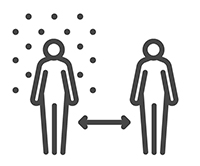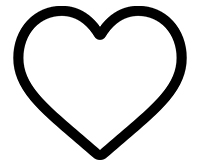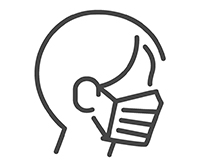
We don’t need to live in fear. Just as our Ancestors have done for thousands of years, we will learn to adapt with a changing environment to keep our people strong.
Contact tracing is strained or over-capacity in many communities, and we have a better shot of slowing the spread of this virus when we know who needs to get tested and/or quarantine. A single person can spread the virus to dozens of people in a single day without knowing it, so the faster someone knows they need to stay home, the better.
There are online tools, including on the State of Alaska’s COVID page, to print out or complete logs with full names and phone numbers for contact tracers. But even a simple notebook or list on your phone you can keep with the name of the person and the date you were in contact can be a huge help in helping us to remember who we saw and on what date.
 Keep as Distant As Possible
Keep as Distant As PossibleWhile we’ve heard the “six foot” rule in regards to how far apart we should be, in reality, the virus can travel in the air much further than initially thought. Scientists have tracked the virus spreading over twenty feet in the air in a matter of minutes. The safest route is not to see people in person at all. But if you are around people, don’t limit your distance to six feet—stay as far apart as you can. Being outside or in a well-ventilated space can help limit transmission, but doesn’t eliminate the risk.
 MAKE SURE TO Check in with Others and Yourself
MAKE SURE TO Check in with Others and YourselfOne of the most difficult parts of this pandemic is how long it is going on with a need to be physically separated from those we love, once safe places shut down, and many without work or with food insecurity, and every-more things to be add stress we didn’t previously have on top of our usual stressors. Checking in with friends and family is more important than ever, whether that’s a quick call, or an extended, regular video setup.
But also make sure you’re paying attention to yourself as well, and prioritizing your own wellness. There is so much need in our communities, but you will serve your community better if you are as healthy as you can be first.
 Keep Up to Date on Face Masks
Keep Up to Date on Face MasksWhile at the beginning of the pandemic the efficacy of masks, and what kind to use, were a moving target. But many studies and lots of community tests have been done since, and not only do we know mask wearing can be one of the most effective ways to slow the spread of COVID, but we have developed “best practices” for mask wearing. Best practices can include:
Make sure you are not only rotating your face masks between washes, but replacing masks after weeks or months of wear. Washing cloth masks is important, but the masks break down and the fibers loosen after anywhere from a few washes to a few dozen, depending on the fabric type. Retire masks frequently – the masks you used at the beginning of the pandemic should not be the masks you’re using now.
Our knowledge of best fabric types for cloth masks keeps developing. In general, at least one layer of tightly woven cotton or other natural material is needed with another layer of cotton or polyester.
We now know neck gaiters and handkerchiefs are not very effective and should not be used as a face covering to prevent COVID. If this is all you have, try to find another, more effective mask or material, but in the meantime try adding a better filter layer, such as a blue shop towel, to your face covering.
Make sure you’re staying up to date with the changing landscape of mask-wearing: https://www.hopkinsmedicine.org/health/conditions-and-diseases/coronavirus/coronavirus-face-masks-what-you-need-to-know